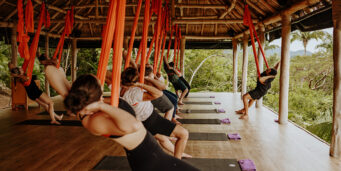Surrender to a higher source (Ishvara pranidhana) is a key teaching in Patanjali's Yoga Sutra ancient yogic texts. These wise words have never resonated more to me than when I got pregnant. For me, pregnancy and childbirth were a long path to surrender and acceptance. A lesson I will never forget and that I always bring to mind when I face any other challenge in my life.
Xinalani's All Inclusive Packages
Physical Challenges
When I turned 28 and became pregnant with Paul, my elder son, I thought nothing of my physical activity had to change. I had a highly active lifestyle including all sorts of sports, dancing, and a regular ashtanga yoga practice. I was strong and healthy and I thought I could confront any challenge coming my way. But after only 10 weeks of pregnancy, I was so depleted and nauseated that I could barely move. The headaches were awful.
Life was not aligning to my plan (surprise!). I was mad, frustrated, and stressed out. I felt trapped in a body that was not listening to me. I felt scared and vulnerable. Little did I know that the skills I had learned on my yoga mat would be of much help to maintain not only my physical health, but my mental and emotional balance. Yogic principles were also the main tool that helped me prepare for a drug-free, water home-birth attended by midwives.
Beautiful Eco Chic Rooms and Beach Casitas
Discovering prenatal yoga
In the first trimester of my pregnancy, my body was exhausted all the time. I started practicing a lot of prenatal yoga restorative asanas, body-softening poses and breathing exercises to relax. In my second trimester I felt a little better and stronger so I happily started to practice a series of strengthening standing poses (most of them from the Ashtanga Yoga Primary Series). I loved doing modified sun salutations A and B, triangle pose and a few hip-openers such as baddha-konasana and upavista konasana. That helped me create overall suppleness and openness.
When I entered my third and last trimester, my curvy and ever changing body blocked me from aligning and getting into my favorite poses. I had to force myself to back off, let go of my ego and listen to my body needs. I learned to use props correctly, I learned more about asana modifications and I worked a lot at a wall. I found relief in practicing modified Urdhva-Dhanurasana or bridge pose. To be honest, during my last month, I had abandoned the idea of a perfect practice and my daily yoga time was about relaxing as much possible, finding comfort in discomfort. I also surprised myself by enjoying the restorative practices more than ever until they became my "magic elixir" and my everyday refuge. My favorite poses became Side-Lying Corpse Pose (side Savasana) and Reclining Bound Angle Pose (Supta Baddha Konasana). My favorite props were a bolster and a big pilates ball.
Practice safely
It is important to consider that there are some asanas that are potentially dangerous during pregnancy, such as twists and deep forward bends or backbends. There are also some restrictions about inversions and most of the teachers do not recommend them. Nevertheless I believe that an experienced yoga student with a longstanding Headstand (Sirsasana) or Shoulderstand (Sarvangasana) practice may safely continue inversions. During the first 6 months of my three pregnancies, safe inversions helped me release tension in my back and especially. The lower abdomen muscles that support the growing weight of the baby are extremely tense. Inversions have done wonders for me in this area.
For a safe prenatal Ashtanga yoga, my bible was Yoga Sadhana for Mothers by Sharmila Desai and Anna Wise.
My mental stability
The biggest benefit I pulled from prenatal yoga was learning deep relaxation techniques. I learned several meditation, visualization, hypnotherapy, and breathwork that helped me cope with the countless mental and emotional changes that pregnancy brought. I practiced along guided meditations everyday in the morning and before going to bed inducing my body to a profound unwind.
I started being aware of how my heart rate slowed and my breathing became deep and rhythmic. These techniques helped my subconscious to release endorphins (calming and pain-relieving hormones), and at the same time stopping it from releasing stress hormones such as adrenaline and cortisol. Now I know that by training my awareness to consciously release tension every night for almost 9 months, I was able to do the same during labor and birth.
For mental health and inspiration, my nightstand favorite books were Birthing from Within by Pam England and Rob Horowitz, and Hypnobirthing by Marie Mongan who by the way also published amazing guided relaxations. I also recommend moms-to-be to take a peek at Orgasmic birth by Elizabeth Davis, Debra Pascali-Bonaro.
Better equipped for childbirth
Along all of the work you do on the mat -building endurance, learning to relax through intense sensations, and coping effectively with anxiety- comes the willingness to surrender to the experience of birth. During labor, surrender translates to releasing into rather than resisting physical sensations. The mind and the ego have to step aside to let your body and nature take control. This means trusting, releasing, letting go of fear and being completely present in every step of the way, and if possible enjoying the ride!
Even though I was blessed with the help of my loving husband and two caring and magnificent midwives who helped on every step of the way, labor was not easy, it was long, intense, and painful. But I can also tell you that I have never experienced a moment as mindful, as sacred and as fulfilling in my entire life. Bliss is the emotion I felt when I held my baby in my arms after a long day of delivery. No drugs were necessary and my dream of having a water home-birth was fulfilled. I felt the most intense gratitude when I was able to nurse him for the first time and sing to him on my very own bed, my love nest.
I know many wonderful and strong women who were forced to let go of their dream natural birth and accept a C-section delivery for medical reasons and I admire them the most. It doesn't matter how you end up giving birth to your child, the important thing to learn is that consistent yoga, meditation and deep relaxation practices can help give you the fortitude, the stamina and the determination to get yourself there in the best shape possible.
About the Author

Co-founder of Xinalani, entrepreneur, yogini and passionate mother of three, Ana Paula has been shaping all sensory things around the Xinalani universe since its very inception in 2009. You will perceive her delicate creativity and her contagious vision in every little detail of the Xinalani experience.




